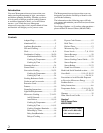
IMPORTANT SAFETY INSTRUCTIONS
(continued)
• Foods with unbroken outer ‘‘skin’’
such as potatoes, sausages, tomatoes,
apples, chicken livers and other
giblets, and egg yolks (see previous
caution) should be pierced to allow
steam to escape during cooking.
SAFETY FACT—Superheated water.
Liquids, such as water, coffee or tea, are
able to be overheated beyond the boiling
point without appearing to be boiling.
Visible bubbling or boiling when the
container is removed from the microwave
oven is not always present. THIS COULD
RESULT IN VERY HOT LIQUIDS
SUDDENLY BOILING OVER WHEN
THE CONTAINER IS DISTURBED OR
A SPOON OR OTHER UTENSIL IS
INSERTED INTO THE LIQUID.
To reduce the risk of injury to persons:
— Do not overheat the liquid.
— Stir the liquid both before and halfway
through heating it.
— Do not use straight-sided containers with
narrow necks.
— After heating, allow the container to stand
in the microwave oven for a short time
before removing the container.
— Use extreme care when inserting a spoon
or other utensil into the container.
• Some products such as whole eggs and sealed
containers—for example, closed glass jars—
are able to explode and should not be heated
in this microwave oven. Such use of the
microwave/convection oven could result in injury.
• Hot foods and steam can cause
burns. Be careful when opening any
containers of hot food, including
popcorn bags, cooking pouches and
boxes. To prevent possible injury, direct
steam away from hands and face.
• Avoid heating baby food in glass jars, even
with the lid off. Make sure all infant food is
thoroughly cooked. Stir food to distribute the
heat evenly. Be careful to prevent scalding
when warming formula or breast milk. The
container may feel cooler than the milk really is.
Always test the milk before feeding the baby.
• Not all plastic wrap is suitable for use in
microwave ovens. Check the package for
proper use.
• ‘‘Boilable’’ cooking pouches and tightly closed
plastic bags should be slit, pierced or vented as
directed by package. If they are not, plastic could
burst during or immediately after cooking,
possibly resulting in injury. Also, plastic storage
containers should be at least partially uncovered
because they form a tight seal. When cooking
with containers tightly covered with plastic wrap,
remove covering carefully and direct steam away
from hands and face.
• Use of the shelf accessory.
— Use pot holders when handling the shelf and
cookware. They will be hot.
— Never use the shelf for microwave-only
cooking. Remove the shelf from the oven
when microwave-only cooking.
— Always place the shelf on the floor of the oven
for convection and combination cooking.
SAVE THESE INSTRUCTIONS
To obtain service, see the Consumer Services page
in the back of this manual.
We’re proud of our service and want you to be
pleased. If for some reason you are not happy with
the service you receive, here are two steps to follow
for further help.
FIRST, contact the people who serviced your
appliance. Explain why you are not pleased.
In most cases, this will solve the problem.
NEXT, if you are still not pleased, write all the
details—including your phone number—to:
Manager, Consumer Relations
GE Appliances
Appliance Park
Louisville, KY 40225
IF YOU NEED SERVICE…
6


















